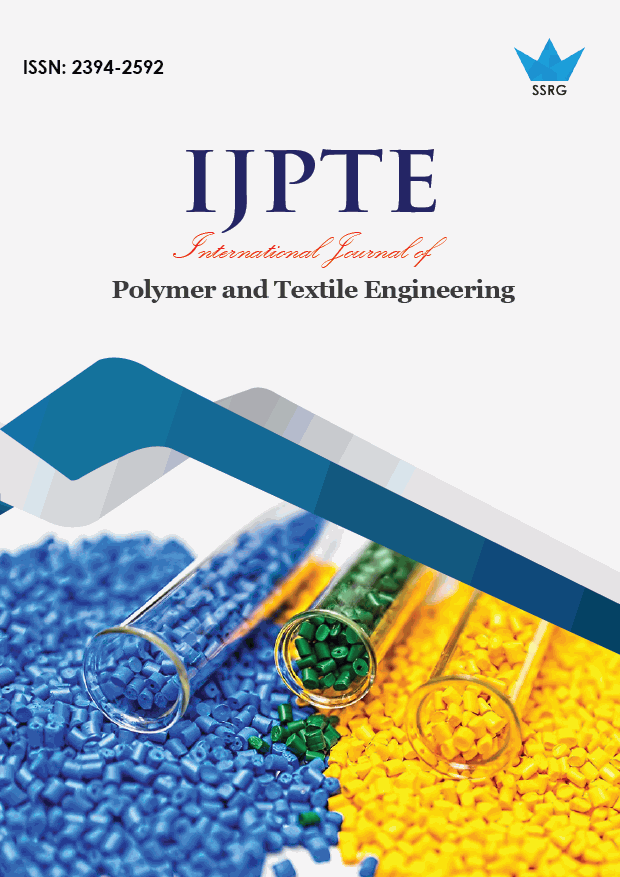A novel approach to a modified spinning technique of staple yarn: Systematic investigation on improvement of physicomechanical characteristics of cotton ring spun yarn

| International Journal of Polymer and Textile Engineering |
| © 2016 by SSRG - IJPTE Journal |
| Volume 3 Issue 2 |
| Year of Publication : 2016 |
| Authors : Mohammad Neaz Morshed, Hridam Deb, Shamim Al Azad, Md. Mahmudul Alam Sarker, Xiaolin Shen |
How to Cite?
Mohammad Neaz Morshed, Hridam Deb, Shamim Al Azad, Md. Mahmudul Alam Sarker, Xiaolin Shen, "A novel approach to a modified spinning technique of staple yarn: Systematic investigation on improvement of physicomechanical characteristics of cotton ring spun yarn," SSRG International Journal of Polymer and Textile Engineering, vol. 3, no. 2, pp. 12-17, 2016. Crossref, https://doi.org/10.14445/23942592/IJPTE-V3I4P102
Abstract:
Producing yarn from natural fibres without creating irregularities in structure or having fibres protruding from the surface, remains the goal of spinners. This is a shortcoming, as structural irregularities such as hairiness, unevenness affect subsequent fabric manufacturing processes and the aesthetics of the final fabric. Sustainability of a noble false twister device and its influence on physical properties of staple cotton yarn has been studied in this research. A false twister has been installed in the ring frame to modify the yarn path of conventional ring spinning system to improve physico-mechanical characteristics of cotton ring spun yarn. This work therefore focused on investigating the effects of varying the spindle speed of a ring spinning frame on the structure of yarn (i.e., its surface regularity and hairiness), its strength with a view to optimizing the spindle speed with this novel false twister. For this, yarns with counts of 15, 20, 25, and 30 tex were produced from 785 tex roving at five different spindle speeds ranging from 6,500 to 8,000 rpm with an interval of 2,000 rpm. All other parameters were kept constant, including the draft for a particular count, the type and weight of the traveller, and the diameter of the ring. Yarn strength, irregularity (u %), coefficient of variation (CV %), actual count (Tex) and actual twist (T/10cm) has been investigated, analysed by YG173A yarn Hairiness Tester, YG133B/M Evenness Tester 4 and YG (B) 021DX tensile strength tester. The results from numerical simulations of modifies spinning system indicate that, physicomechanical characteristics of cotton ring spun yarn has been improved in a considerable value. Thus points the speeding up of productivity of the yarn manufacturing.
Keywords:
False twister, Staple Yarn, Yarn strength, Irregularity, Hairiness.
References:
[1] Salhotra, K., An overview of spinning technologies: Possibilities, applications and limitations. Indian Journal of Fibre and Textile Research, 1992. 17: p. 255-255.
[2] Göktepe, F., D. Yilmaz, and Ö. Göktepe, A comparison of compact yarn properties produced on different systems. Textile Research Journal, 2006. 76(3): p. 226-234.
[3] Haleem, N. and X. Wang, Recent research and developments on yarn hairiness. Textile Research Journal, 2015. 85(2): p. 211-224.
[4] Khan, Z.A., Investigation of post-spinning yarn engineering. 2003, Deakin University.
[5] Wang, X. and L. Chang, Reducing yarn hairiness with a modified yam path in worsted ring spinning. Textile research journal, 2003. 73(4): p. 327-332.
[6] Thilagavathi, G., et al., Yarn hairiness controlled by various left diagonal yarn path offsets by modified bottom roller flute blocks in ring spinning. Indian journal of fibre & textile research, 2009. 34(4): p. 328.
[7] Barella, A., X. Bardi, and L. Castro, Hairiness modification by yarn/yarn and yarn/metal friction. Melliand Textilber, 1991. 72(1): p. E3-E4.
[8] Hua, T., et al., Effects of geometry of ring spinning triangle on yarn torque part I: Analysis of fiber tension distribution. Textile Research Journal, 2007. 77(11): p. 853-863.
[9] Feng, J., et al., Theoretical study of a spinning triangle with its application in a modified ring spinning system. Textile Research Journal, 2010.
[10] Wang, X., Recent Research on Yarn Hairiness Testing and Reduction. Journal of Textile and Apparel, 1998. 2(1): p. 13- 20.
[11] Martindale, J., A Review of the causes of yarn irregularity. Journal of the Textile Institute Proceedings, 1950. 41(7): p. 340-356.
[12] Wang, X., M. Miao, and Y. How, Studies of JetRing spinning Part I: Reducing yarn hairiness with the JetRing. Textile Research Journal, 1997. 67(4): p. 253-258.
[13] Tyagi, G., et al., Effect of spinning conditions on mechanical and performance characteristics of cotton ring-and compactspun yarns. Indian journal of fibre & textile research, 2010. 35(1): p. 21.
[14] Yilmaz, D. and M.R. Usal, Improvement in yarn hairiness by the siro-jet spinning method. Textile Research Journal, 2013. 83(10): p. 1081-1100.
[15] Artzt, P., The special structure of compact yarns-advantages in downstream processing. ITB Yarn And Fabric Forming, 1997. 2: p. 41-48.
[16] Cheng, K. and C. Yu, A study of compact spun yarns. Textile Research Journal, 2003. 73(4): p. 345-349.
[17] Yilmaz, D. and M.R. Usal, A comparison of compact-jet, compact, and conventional ring-spun yarns. Textile Research Journal, 2011. 81(5): p. 459-470.
[18] Grosberg, P. and C. Iype, Yarn production: Theoretical aspects. 1999: Textile Institute.
[19] Zeng, Y. and C. Yu, Numerical and experimental study on reducing yarn hairiness with the JetRing and JetWind. Textile research journal, 2004. 74(3): p. 222-226.
[20] Stahlecker, H., RoCoS Rotorcraft Compact Spinning: Magnetic Compacting. 2005.
[21] Subramanian, S., et al., Variation in imperfections level due to winding of ring yarn. Indian J Fibre Text Res, 2007. 32: p. 290-294.
[22] Dash, J.R., S. Ishtiaque, and R. Alagirusamy, Properties and processibility of compact yarns. Indian Journal of Fibre and Textile Research, 2002. 27(4): p. 362-368.

 10.14445/23942592/IJPTE-V3I4P102
10.14445/23942592/IJPTE-V3I4P102